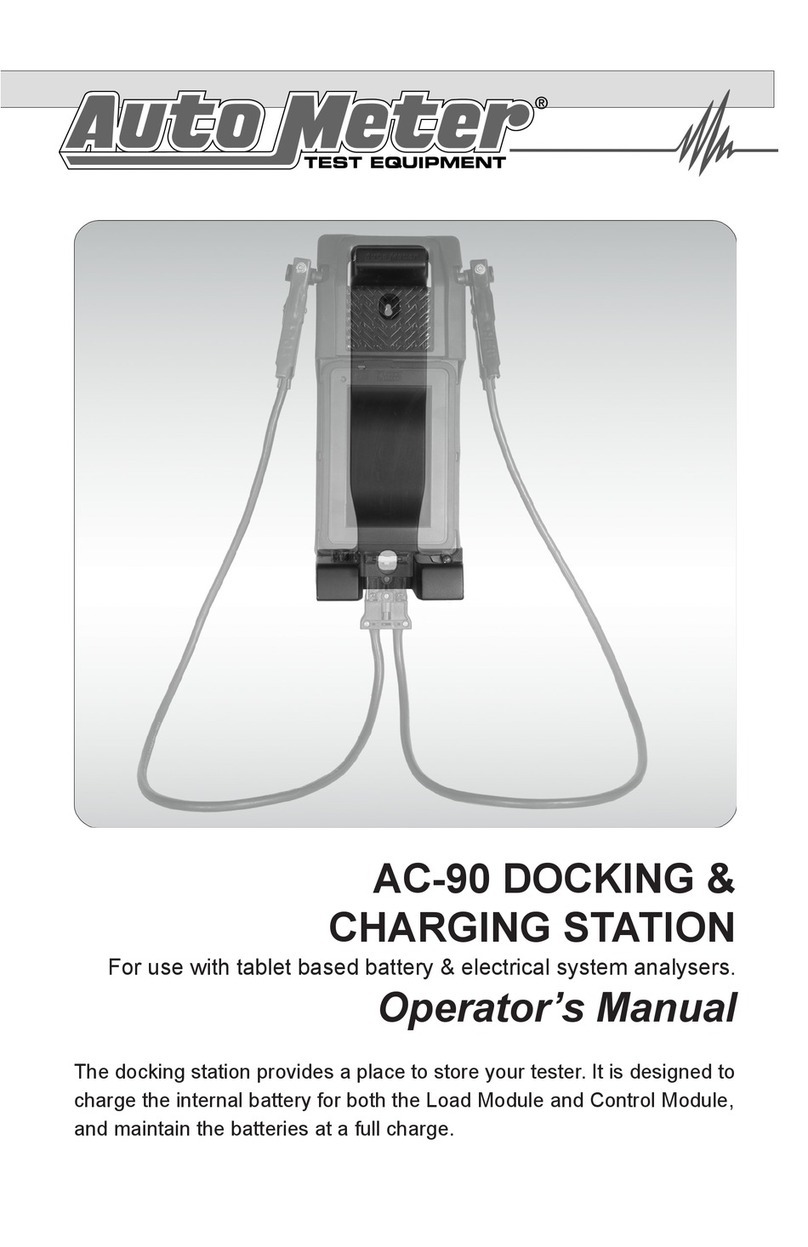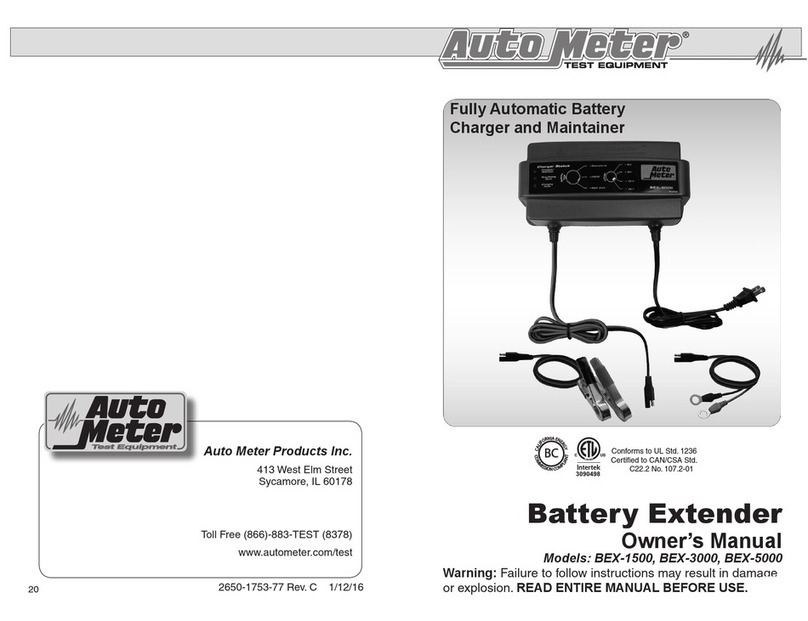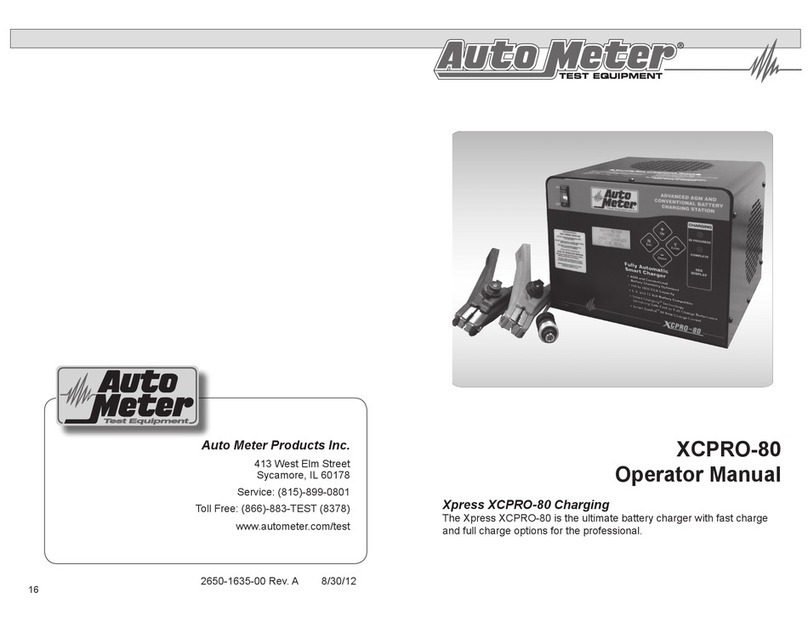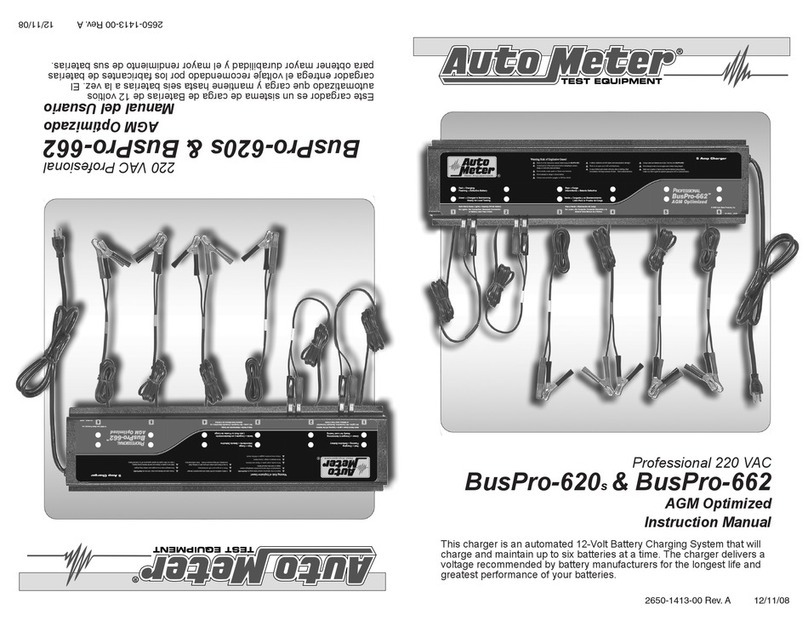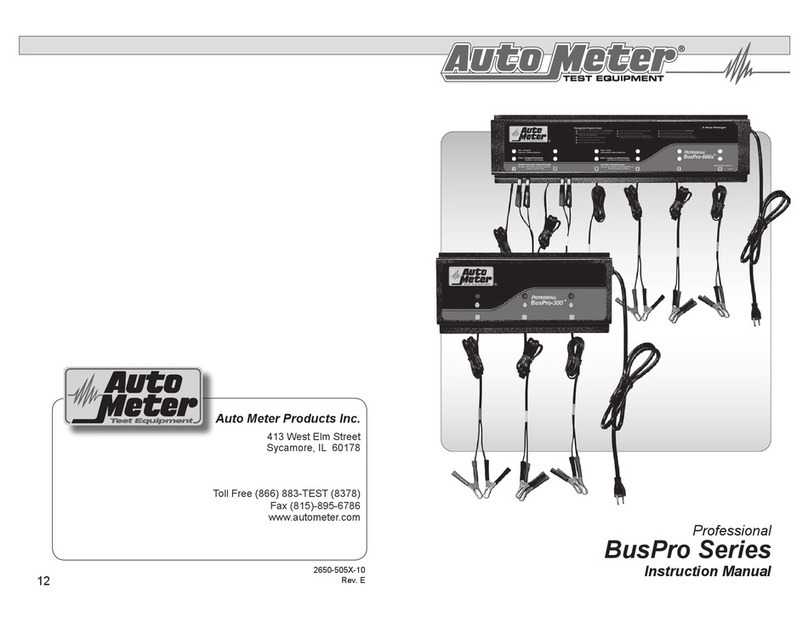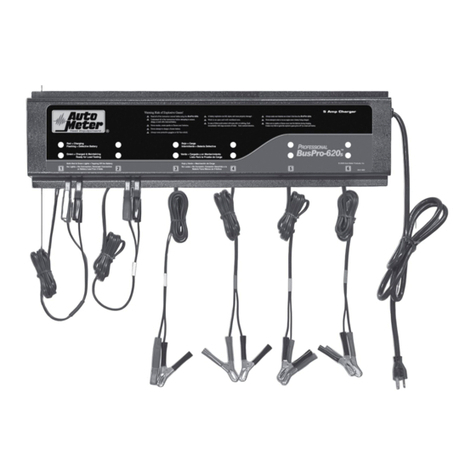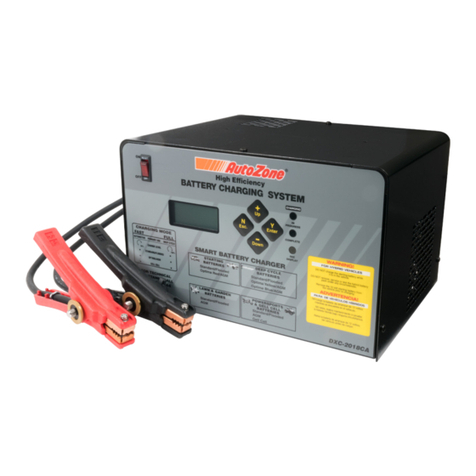AutoMeter BusPro Series User manual

BusPro-660.
AGM Optimized
®
65
4
32
©2008 Auto Meter Products, Inc.
BusPro-660
1
BusPro-660.
Red = Charging
Flashing = Defective Battery
Green = Charged & Maintaining
Ready for LoadTesting
Both Red & Green Lights =Topping off the Battery
No Lights = No Connection, ReversedConnection
or Battery LessThan 2 Volts
Rojo = Carga
Intermitente = Bateria Defectiva
Verde= Cargada y en Mantenimiento
Listo Para la Prueba de Carga
Rojo yVerde = Maximación de Carga
No Luces = No Conexión, ConexiónDevertida o la
BateríaTiene Menos de 2 Voltios
BusPro-360
©2008 Auto Meter Products, Inc. 2511-2560-00
Warning Risk of Explosive Gases!
Readand understand all of the instructions.
Neversmoke, create sparks or flames near batteries.
Neverattempt to charge a frozen battery.
Alwayswear protective goggles or full face shield.
Abattery explosion can kill, injure and cause property damage.
Workin an open and well ventilated area.
Incase of direct acid contact with eyes, skin or clothing, flush
immediatelywith large amounts of water. Seekmedical attention.
Alwaysmake sure batteries are at least two feet from
BusPro-360
.
Neverattempt to start or run engine near a battery being charged.
Makesure no sparks or flames occur near the batteries during charging.
Ittakes very little to ignite the explosive gases given off by the lead-acid
battery.
AGM Optimized
32
1
®
Professional 120 VAC
BusPro Series
Instruction Manual
BusPro-660.
AGM Optimized
®
65
4
32
©2008 Auto Meter Products, Inc.
BusPro-660
1
BusPro-660.
Red = Charging
Flashing = Defective Battery
Green = Charged & Maintaining
Ready for LoadTesting
Both Red & Green Lights =Topping off the Battery
No Lights = No Connection, ReversedConnection
or Battery LessThan 2 Volts
Rojo = Carga
Intermitente = Bateria Defectiva
Verde= Cargada y en Mantenimiento
Listo Para la Prueba de Carga
Rojo yVerde = Maximación de Carga
No Luces = No Conexión, ConexiónDevertida o la
BateríaTiene Menos de 2 Voltios
BusPro-360
©2008 Auto Meter Products, Inc. 2511-2560-00
Warning Risk of Explosive Gases!
Readand understand all of the instructions.
Neversmoke, create sparks or flames near batteries.
Neverattempt to charge a frozen battery.
Alwayswear protective goggles or full face shield.
Abattery explosion can kill, injure and cause property damage.
Workin an open and well ventilated area.
Incase of direct acid contact with eyes, skin or clothing, flush
immediatelywith large amounts of water. Seekmedical attention.
Alwaysmake sure batteries are at least two feet from
BusPro-360
.
Neverattempt to start or run engine near a battery being charged.
Makesure no sparks or flames occur near the batteries during charging.
Ittakes very little to ignite the explosive gases given off by the lead-acid
battery.
AGM Optimized
32
1
®
Profesional 120 VAC
Series BusPro
Manual del Usuario
2650-1412-00 Rev. B 12/23/08
2650-1412-00 Rev. B 12/23/08

2
BUSPRO SERIES
SPECIFICATIONS
2
SERIES BUSPRO
ESPECIFICACIONES
Carga..................................................................Baterías de 12 voltios
Entrada...............................................................220 VCA @ 2.5 Amps
Modo de salida de la carga .... 5 amperios Máx./10 Amps BusPro-361
Mantenimiento del modo de descarga ....... 0 á 2.5 Amp.variación sea
necesaria 0 á 5 Amp con el BusPro-361
Abrazaderas ...................................................................6 piés. 18 GA.
BusPro 361 - 6 piés 16 GA
Tamaño........................................................ BusPro-600s, 660, & 361
26” Largo 8” Alto 3.25” Profundo
BusPro-300 & 360
14” Largo 8” Alto 3.25” Profundo
Peso ............................................... 31 lbs. - BusPro-600s, 660 & 361
17 lbs. - BusPro-300 & 360
Abrazaderas Opcionales AC-8 ........................................Juego de seis
CONTENIDO
Instrucciones de Seguridad................................................................ 3
Seguridad Personal ........................................................................... 4
Como Alistar el Cargador ................................................................... 5
Inspección de la Batería .................................................................... 6
Como conectar las Abrazaderas ....................................................... 7
Como leer las Luces Indicadoras ................................................... 6-7
Como Desconectar el cargador 8 Conexión Potencial (3 unidades juntas
y abrazaderas opcionales) ................................................................ 9
Que puede Esperar de su cargador ................................................ 10
Información de Garantía y Servicio ..................................................11
Información de Contacto y Advertencias.......................................... 12
CONTENTS
Safety Instructions...................................................................3
Personal Safety .......................................................................4
Setting Up the Charger............................................................5
Inspecting The Battery.............................................................6
Hooking up the Clamps ...........................................................7
Reading the Indicator Lights.................................................6-7
Disconnecting the Charger......................................................8
Hookup Potential (3 units together and optional leads)...........9
What to Expect from your Charger........................................10
Warranty and Service Information ......................................... 11
Contact Information & Warnings............................................12
Charges...........................................................12 Volt Batteries
Input........................................................... 120 VAC @ 5 Amps
Charging & Output Mode
........ 5 Amps Max/10 Amps BusPro-361
Maintenance Output Mode
............. 0-2.5 Amp variation as needed
0-5 Amp with BusPro-361
Leads..................................................................... 6 Ft. 18 GA.
BusPro-361 - 6 Ft. 16 GA.
Size................... Bus-Pro-660s, 660 & 361 - 26"W 8"H 3.25"D
Bus-Pro-300 & 360 - 14"W 8"H 3.25"D
Weight ............................... Bus-Pro-660s, 660 & 361 - 31 lbs.
Bus-Pro-300 & 360 - 17 lbs.
Optional AC-8 Jumper Leads .................................... Set of Six

3
3
SAFETY INSTRUCTIONS
WARNING:
Lead Acid Batteries are Dangerous! During use and charging they
may generate EXPLOSIVE Hydrogen Gas. This means YOU MUST
carefully read all of the safety and operating instructions before using
the chargers. Be sure you understand all of the safety instructions in
this manual before attempting to connect, charge, or work with a lead
acid battery.
GENERAL SAFETY RULES FOR SAFE OPERATION
Batteries are dangerous. Auto Meter provides the following Warnings for
your safety:
1. Use the BusPro-300 and BusPro-600s chargers only on 12 Volt LEAD ACID.
Use the BusPro-360, BusPro-361, and BusPro-660 on 12 Volt LEAD ACID,
AGM batteries DO NOT attempt to use on other types of batteries (Dry Cell,
Nickel Cadmium, Nickel Metal Hydride, etc.) commonly found in small home
appliances. This may cause the batteries to burst, resulting in damage or
injury to person and/or property.
2. DO NOT use the charger on batteries that are in use or that are installed.
3. DO NOT use attachments with the charger that are not approved or sold by
manufacturer. Non-approved attachments may result in injury, electric shock,
or re and voids the warranty.
4. When disconnecting the power cord from the wall, grasp the plug and pull.
Never pull the cord, it may damage the plug and/or the cord.
5. Place the power cords in a location where they will not be stepped on,
tripped over, or subjected to stress or abuse of any kind.
6. Never operate the charger if any portion of its housing, cords or attachments
appear to be damaged in any way. If damage has occurred, have it
inspected and serviced by the manufacturer.
7. If the charger has been dropped, received a sharp blow, or abused in any
way, have it inspected and repaired by the manufacturer if necessary.
8. Do not use an extension cord to operate the charger. An inadequate
extension cord could result in re or explosion due to a large number of
batteries being charged and will not provide the AC amperage rating needed
by the charger.
9. Each charging Station has its own AC fuse. Other than this fuse
replacement, the manufacturer should be contacted for trouble shooting
and instructions on how to repair or replace parts and charging stations.
Any unauthorized repair, tampering or incorrect assembly may result in re
or electric shock and voids the warranty. Check with the manufacturer for
instructions.
10. To prevent injury during cleaning or maintenance, disconnect all batteries
and move them away from the unit. Unplug the charger from the wall outlet
(grasping the plug). Use a slightly dampened cloth to clean the housing and
lead sets. Do not use solvents or soaps.
INSTRUCCIONES DE SEGURIDAD
¡ADVERTENCIA! :
¡Las baterías de ácido de plomo son Peligrosas! Durante el uso y la
carga pueden generar gas EXPLOSIVO de Hidrógeno. Esto signica
que USTED DEBE leer cuidadosamente todas las instrucciones de
seguridad y operación antes de usar el cargador. Asegúrese de entender
todas las instrucciones de seguridad en este manual y en el cargador
antes de intentar conectarlo, cargar o trabajar con una batería de ácido
de plomo.
REGLAS GENERALES DE SEGURIDAD PARA UNA OPERACIÓN SEGURA
La baterías son peligrosas. Auto Meter recomienda las siguientes
Advertencias para su seguridad:
1. Use los cargadores BusPro-300 y el BusPro-600s únicamente en baterías
de ÁCIDO PLOMO de 12 Vóltios. Use el cargador BusPro-360, BusPro-361
y el BusPro-660 con baterías de 12 Vóltios de ÁCIDO PLOMO, baterías
AGM. No intente usarlo en otros tipos de baterías de (Células Secas,
Níquel-Cadmio, Hidrato Metálico de Níquel, etc.) comúnmente usadas en
pequeños electrodomésticos. Hacerlo podría provocar que las baterías
exploten, resultando en daños y lesiones físicas y/o materiales.
2. NO use el cargador en baterías que están en uso o que están instaladas
3. NO use accesorios que no están aprovados para el cargador o que no sean
vendidos por Auto Meter. Accesorios que no son aprobados pueden causar
lesiones, choque eléctrico, o incendio y anula la garantía.
4. Cuando desconecte el cordón eléctrico de la pared, agarre el enchufe y jale.
Nunca jale el cordón, puede dañar el enchufe y/o el cordón.
5. Ubique los cordones eléctricos en un lugar donde no sean pisados,
tropezados, o sujetos a tirones o abuso de ningún tipo.
6. Nunca opere el cargador si cualquier parte de su carcasa, alambres o
accesorios estan dañados de cualquier manera. Si ha ocurrido algún daño,
hágalo inspeccionar y reparar por Auto Meter.
7. Si ha dejado caer el cargador, o recibido un golpe fuerte, o ha sido mal
usado de alguna forma, hágalo inspeccionar y reparar por Auto Meter si es
necesario.
8. No use un cable de extensión eléctrico para operar el cargador. Un alambre
de extensión inapropiado puede causar fuego o explosión debido al gran
número de baterías que estén siendo cargadas y que no pueda proveer la
corriente amperia AC necesaria para el cargador.
9. Cada Estación de carga tiene su propio fusible de corriente AC. Aparte del
reemplazo de este fusible, debe contactar al fabricante para solucionar
problemas de funcionamiento o para instrucciones de cómo reparar,
reemplazar partes o estaciones de carga. Cualquier reparación inautorizada,
manipulación o ensamble incorrecto puede resultar en fuego o choque
eléctrico y anula la garantía. Verique con Auto Mete para instrucciones.
10. Para evitar daños durante la limpieza o mantenimiento, desconecte todas
las baterías y aléjelas de la unidad. Desenchufe el cargador de la pared
(agarrando el enchufe). Use un trapo húmedo para limpiar la carcasa y el
juego de abrazaderas. No use solventes o jabones

IMPORTANTE
USE
ANTEOJOS
PROTECTORES
11. NUNCA intente cargar una batería congelada. Deje que la batería vuelva a
la temperatura normal ambiente antes de conectarla.
12. SIEMPRE usa el cargador en un área abierta y bien ventilado. El área debe
estar seco y libre de basura, partículas metálicas y combustibles.
13. ¡ADVERTENCIA! Gas explosivo de Hidrógeno puede estar presente cerca
de las baterías.
14. No usa el cargador directamente bajo el sol o condiciones adversas como la
lluvia o la nieve.
15. Monte el cargador en una pared segura a por lo piés arriba de las baterías
que son cargadas. Esto evitará que goteos o derrames de ácido caigan
sobre el cargador durante el relleno de la batería o durante pruebas de la
gravedad especíca. Esto también evita que los gases de la baterías lleguen
en contacto con el cargador.
16. No coloque objetos pequeños o herramientas sobre la unidad instalada.
17. NUNCA usa el cargador en o sobre ningún bote o máquina acuática. Debe
remover la batería del bote o máquina acuática y cargar la batería en el
lugar adecuado donde se halla instalado la unidad de carga.
18. NO instale el cargador donde esté expuesto a la humedad, inclemencias del
clima ni cerca de combustibles, líquidos inamables o vapores y basura.
INSTRUCCIONES DE SEGURIDAD Cont.
PRECAUCIONES PARA
SEGURIDAD PERSONAL
1. Use anteojos de protección o un casco con escudo completo.
2. Use ropas de seguridad. No deje la piel expuesta.
3. Have plenty of fresh water and hand soap available for use if acid should
contact your eyes, skin or clothing.
4. Tenga suciente agua y jabón de manos disponible para usarlos si el ácido
llega a tener contacto con sus ojos, piel o ropa.
5. Quítese todos los objetos metales (lapiceros, herramientas, joyas, etc.) de
su cuerpo. Estos objetos pueden causar un corto entre los terminales de la
batería y quemaduras serias.
6. NO cargue herramientas u objetos metálicos en la cercanía de una batería.
Estos objetos pueden caer sobre los terminales de la batería causando
un corto de alta corriente. Esto puede ocasionar un fuego, quemaduras,
explosiones, etc.
7. NO toque su cara, ojos o cualquier otra parte del cuerpo sin antes lavarse las
manos. El ácido de Batería puede quemar o irritar el tejido ocular o la piel.
8. NO deje que alguna fuente de ignición en el área de una batería. Mantenga
todos los dispositivos que produzcan llamas o chispas lejos del área y
NUNCA FUME cerca de una batería.
9. Use la regla de una mano! Mantenga una mano en su bolsillo cada vez que
haga una conexión eléctrica. Esto reduce el riesgo de choque eléctrico al
usuario.
4
4
11. NEVER attempt to charge a frozen battery. Allow the battery to return to
room temperature before connection.
12. ALWAYS use the charger in an open and well-ventilated area. The area
should be dry and free of trash, debris and combustibles.
13. WARNING! Explosive Hydrogen gas may be present around batteries.
14. Do not use the charger in direct sunlight or adverse weather conditions such
as rain or snow.
15. Mount the charger on a secure wall location at least two feet above the
batteries being charged. This prevents acid drips and spills from landing on
the charger during battery lling or specic gravity testing. This also prevents
battery fumes from reaching the charger.
16. Do not place small objects or tools on the top edge of the mounted unit.
17. NEVER use the charger in or on any boat or watercraft. You must remove
the battery from the boat or watercraft and charge the battery at the properly
installed location of the charger unit.
18. DO NOT install the charger where it will be exposed to moisture, inclement
weather nor around combustibles, ammable liquids or vapors and
trash.
SAFETY INSTRUCTIONS Cont.
PERSONAL SAFETY PRECAUTIONS
1. Wear protective goggles or a full-face shield.
2. Wear protective clothing. Leave no exposed skin.
3. Have plenty of fresh water and hand soap available for use if acid should
contact your eyes, skin or clothing.
4. Have someone close by in the event you need emergency assistance when
working with a battery.
5. Remove all metal objects (pens, tools, jewelry, etc.) from your body. These
items can create a direct short between the battery terminals and can cause
serious burns.
6. DO NOT carry tools or metal objects within the vicinity of a battery. These
items can fall on the battery terminals creating a high current short. This
could result in a re, burns, explosion, etc.
7. DO NOT touch your face, eyes or other body parts with out rst washing
your hands. Battery acid can burn and irritate eye and skin tissue.
8. DO NOT allow any source of ignition in the area of a battery. Keep all ame
and spark producing devices out of the area and NEVER SMOKE near a
battery.
9. Use the one hand rule! Keep one hand in your pocket whenever you make
an electrical connection. This reduces the risk of electrical shock to the user.

5
5
1SETTING UP THE BusPro Charger
The charger has two mounting keyholes. YOU MUST mount the charger
to a wall that provides a secure surface. This will keep it out of the way
and prevent damage due to accidents. If needed, you may leave the two
screws slightly extended from the wall to allow easy removal through the
keyhole slots.
Connect the
charger to a grounded
120-Volt AC power receptacle
that is wired in compliance with local
electrical codes. If you do not know how to test a receptacle for proper
ground, have a qualied electrician test it for you. A grounded receptacle
will receive a plug with a round ground pin and two blade terminals.
If the outlet will not receive a plug with a ground pin, you will need a
temporary-ground adapter with a metal grounding tab shown to the right.
Be sure the metal ground tab is securely screwed into the faceplate as
shown. Use this adapter only as a temporary means of connection. Have
a qualied electrician install a proper receptacle as soon as possible.
WARNING! Do not alter the plug or cord on the charger. Any alterations
will void the warranty.
Caution: In determining placement of the charger check the following:
• Make sure the batteries can be placed at least two feet away. For
example, If the batteries are placed on the oor make sure the
charger is mounted securely at least two feet above, but no
more than the working length of the leads.
• Make sure the room has plenty of ventilation.
• Make sure no sparks or ames can occur near the charging area.
• Mount the charger away from vehicle repair or service area.
• Never start or run an engine near the batteries being charged. It
takes very little to ignite explosive gases given off by a lead-acid
battery. Remember: You may be charging several batteries at a
time. This compounds the need for a strict safety program.
See page 9 for hooking up three charger units together.
1
COMO ALISTAR EL Cargador BusPro
EL cargador BusPro-600s tiene dos oricios para montarlo. DEBE
montar el cargador en una pared que proporcione supercie segura.
Esto lo mantendrá fuera del camino y prevendrá daños accidententales.
Si es necesario, puede dejar los dos tornillos pocamente extendidos de
la pared para permitir un desmontaje fácil de los oricios de montaje.
Conecte el cargador a un
receptáculo de tierra con corriente
de 120-AC que esté alambrado en
cumplimiento con el código eléctrico local. Si no sabe como probar el
tierre del receptáculo, haga que un eletricista calicado se lo pruebe. Un
receptáculo de tierra acepta un enchufe con postillo de tierra redondo
y dos de cuchillas terminals. Si el enchufe no acepta un enchufe con
postillo de tierra redondo, usted necesitará un adaptador de tierra-
temporario con lengüeta de metal como el que es mostrado a la
derecha. Use este adaptador sólo temporariamente para la conexión.
Haga que un electricista calicado le instale un receptáculo apropiado lo
más pronto posible. ADVERTENCIA! No cambie el cordón del cargador.
Cualquiercambio anulará la garantía.
Precaución: Para determinar la ubicación ideal del cargador chequée lo siguiente:
• Asegúrese que las baterías se pueden colocar al menos 2 piés de
distancia. Por ejemplo, si las baterías se colocan en el piso, asegúrese
que el cargador está montado rmemente por lo menos dos pies
arriba, pero no más separado de la distancia de alcance de las
abrazaderas.
• Asegúrese que el espacio tenga suciente ventilación.
• Asegúrese que no se haigan chispas o amas cerca del área de carga.
• Monte el cargador lejos de vehículos en reparación o áreas de servicio.
• Nunca arranque o ande un motor cerca de las baterías que se están
cargando. Toma muy poco encender gases explosivos emitidos
por una batería de ácido-de plomo. Recuerde: Usted puede estar
cargando varias baterías a la vez. Esto demanda la necesidad de un
programa de seguridad estricto.
Lea la página 9 para como conectar hasta tres unidades juntas.
CONEXIONES
APROPIADAS DE
CORRIENTE AC
Lenquenta de
Tierra Metal
PROPER
AC POWER
CONNECTIONS
Metal
Grounding Tab
Other manuals for BusPro Series
1
Table of contents
Other AutoMeter Batteries Charger manuals
